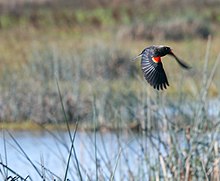Vic Fazio Yolo Wildlife Area

In 2001, the Wildlife Area expanded to over 16,000 acres (65 km) through the acquisition of the Glide and Los Rios properties. Since this time, extensive wetland enhancement and restoration projects have proceeded rapidly. The Department of Fish and Wildlife has incorporated agriculture into the management of the property to generate operating income and to provide wildlife habitat.
The floodplain that makes up the Yolo Bypass receives water from the Sacramento River and provides an Important Bird Area of the Pacific Flyway for an impressive variety of waterfowl. Unless the area is impassable due to normal seasonal flooding, a dirt and gravel road is open to the public for driving and walking tours, and a docent-led tour is given once per month.
It is one of the sites recommended by California's Department of Fish and Wildlife for wildlife viewing.
External links
References
- ^ "Yolo Bypass Wildlife Area Land Management Plan" (PDF). June 2008. Archived (PDF) from the original on April 18, 2024. Retrieved April 18, 2024.
- ^ Brice, Ann (Winter 2015). "The Yolo Bypass Wildlife Area: History, Management and Significance for Birds" (PDF). p. 4. Archived (PDF) from the original on January 28, 2022.
- ^ "Sacramento Regional Wildlife Viewing". wildlife.ca.gov. Archived from the original on April 18, 2024. Retrieved April 18, 2024.